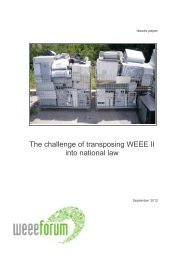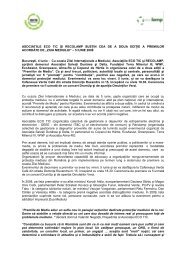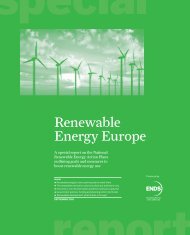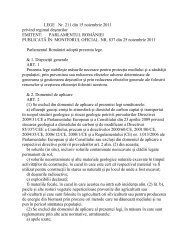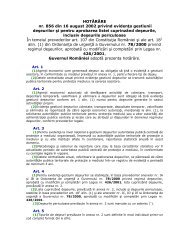PCB's in Small Capacitors from Waste Electrical and ... - Ecotic
PCB's in Small Capacitors from Waste Electrical and ... - Ecotic
PCB's in Small Capacitors from Waste Electrical and ... - Ecotic
Create successful ePaper yourself
Turn your PDF publications into a flip-book with our unique Google optimized e-Paper software.
PCB’s <strong>in</strong> <strong>Small</strong> <strong>Capacitors</strong> <strong>from</strong> <strong>Waste</strong> <strong>Electrical</strong> <strong>and</strong> Electronic Equipments<br />
Table 9: Estimation of the PCB fl ows 2006 <strong>from</strong> small capacitors <strong>in</strong> diverse categories of waste<br />
electrical <strong>and</strong> electronic equipments<br />
Device Category <strong>Capacitors</strong> 2006 8 [ t ] PCB Content [ mg/kg ] PCB Flows 2006 [ kg/a ]<br />
LHA 62 1’500–16’500 Ca. 90–1’020<br />
SHA 51 350–440 Ca. 20<br />
Fluorescent tube lamps 13 24’500–250’000 Ca. 330–3’330<br />
Cool<strong>in</strong>g <strong>and</strong> freez<strong>in</strong>g<br />
appliances<br />
1.5 5 0<br />
IT/CE 33 1’080–1’900 Ca. 40–60<br />
Total Ca. 500–4’400<br />
8<br />
The amount of capacitors per category has been estimated on the total; the amount of fl uorescent tube lamps, however, is very uncerta<strong>in</strong>.<br />
4.2 Annual PCB Flows<br />
PCB values measured <strong>and</strong> yearly amounts of processed<br />
devices <strong>and</strong> capacitors allow the estimate of PCB fl ows<br />
<strong>from</strong> small capacitors <strong>in</strong> electrical <strong>and</strong> electronic equipments.<br />
Most notably, the amount of capacitors per<br />
category is evaluated, as the companies are not differentiat<strong>in</strong>g<br />
them accord<strong>in</strong>g to the categories. The ranges<br />
shown <strong>in</strong> Table 9 come <strong>from</strong> the analytical uncerta<strong>in</strong>ties<br />
(see paragraph 4.1). Obviously, > 95 % of the PCB fl ow<br />
orig<strong>in</strong>ates <strong>from</strong> large household appliances (90 –<br />
1’020 kg/a) <strong>and</strong> ballasts <strong>in</strong> fl uorescent tube lamps<br />
(330 – 3’330 kg/a). This annual fl ow of 500 – 4’400 kg/a<br />
<strong>from</strong> WEEE is to be related with fl ows <strong>in</strong> the environment<br />
<strong>and</strong> earlier consumption data. Dist<strong>in</strong>ctly lower PCB<br />
fl o ws result <strong>from</strong> small household appliances, IT <strong>and</strong><br />
CE. With regard to the very small PCB concentrations <strong>in</strong><br />
capacitors <strong>from</strong> cool<strong>in</strong>g <strong>and</strong> freez<strong>in</strong>g appliances, this<br />
fl o w is <strong>in</strong>signifi cant. In Table 9, the annual PCB fl ows<br />
2006 are compiled.<br />
Accord<strong>in</strong>g to a study by the Swiss Federal Offi c e for the<br />
Environment (BUWAL 1994), the total yearly atmospheric<br />
PCB deposition is rated 2’000 – 8’000 kg/a. For a major<br />
part, this deposition emanates <strong>from</strong> the remobilisation<br />
of already present environmental contam<strong>in</strong>ations.<br />
Ballasts <strong>from</strong> fl uorescent tube lamps, contam<strong>in</strong>ated oils<br />
<strong>from</strong> motors, transformers <strong>and</strong> switches, contam<strong>in</strong>ated<br />
fl o ors <strong>in</strong> scrap treatment plants <strong>and</strong> former PCB users<br />
are cited as primary anthropogenic sources for a possible<br />
new entry. In this study, small capacitors <strong>from</strong><br />
household appliances are considered as <strong>in</strong>signifi cant<br />
sources, <strong>and</strong> the load due to waste electronic equipment<br />
(IT/CE) is rated as m<strong>in</strong>or.<br />
Bas<strong>in</strong>g upon offi c ial statistical enquiries, net imports,<br />
consumption fi gures <strong>and</strong> waste exports of PCB for<br />
Switzerl<strong>and</strong> <strong>in</strong> 1975-1984 are registered <strong>in</strong> Fig. 3. The<br />
total consumption <strong>in</strong> the course of these 10 years ranged<br />
around 600 t. The latter are not <strong>in</strong>clud<strong>in</strong>g the imported<br />
small capacitors (BUWAL 1994). In this same study,<br />
the consumption of PCB’s <strong>in</strong> ballasts <strong>in</strong> fl uorescent tube<br />
lamps has been derived <strong>from</strong> German conditions. Thus,<br />
a yearly total averag<strong>in</strong>g 50 t was supposedly used <strong>in</strong> the<br />
time span 1959 –1980 for this purpose exclusively. In<br />
fl u orescent tube lamps disposed of under control, approximate<br />
5 % of the former consumption are supposed<br />
to be dealt with about 50 years later. Tak<strong>in</strong>g <strong>in</strong>to account<br />
the fact that nearly 50 % of the capacitors <strong>in</strong> ballasts<br />
orig<strong>in</strong>ate <strong>from</strong> the bulk sample between 1960 <strong>and</strong> 1980<br />
(see Annex C), the calculated fl ow of 0.3 – 3 t/a is very<br />
small – a further <strong>in</strong>dication that the largest share of fl u-<br />
orescent tube lamps is be<strong>in</strong>g disposed of uncontrolledly<br />
with the metal scrap. On 29.7.1983, the production of<br />
PCB-conta<strong>in</strong><strong>in</strong>g small capacitors was stopped (BUWAL<br />
1994).<br />
14



